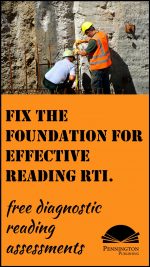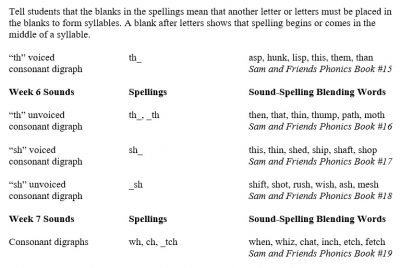
The Problems with Fluency Assessments
The heart of effective reading intervention is assessment-based instruction. The devil is in the details, especially with respect to the diagnostic (and placement) reading assessments. This article focuses on reading fluency assessments.
Background
As a reading specialist, I’ve worn three different hats in four different grade-level settings. My first hat has been worn as a district trainer of trainers and professional development instructor for elementary, middle, and high school teachers. My second hat has been worn as a site-level reading program diagnostician and supervisor at the eight elementary schools and one high school. My third hat has been worn as a reading intervention teacher in grades 4–6 elementary, grade 7 middle school, grade 9 high school, and the reading lab at a community college.
What I Learned
After earning my M.A. as a reading specialist, I began my three-hat, four grade-level setting career. I quickly learned that my grad school experience provided the theoretical framework, but not the tools (specifically the assessment tools) to ply my trade. As I learned and developed those assessment tools in the real world of teachers and their classrooms, I found that teachers were more than willing to try some new tools, but the tools had to be on their terms and conditions.
Teacher Terms and Conditions
1. Minimal expenditure of assessment time including testing, correction, data recording, data analysis, progress monitoring, and grade-level or school-wide meetings.
2. Minimal expense for testing tools. Teachers prefer spending school and personal money on teaching, not testing, resources. After all, teachers got into the business to teach, not to test.
3. Teachable assessment tools. Teachers love meaningful and simple test data, but only quantitative data. Teachers don’t like the random sample tests that university professors produce. Teachers prefer comprehensive test data which identify learning gaps that teachers can tackle in their instruction.
4. No evaluations based upon progress monitoring. Teachers are at different places on their learning curves and are teaching uncontrolled variables, that is their students, with behavioral issues, language challenges, soci0-economic issues, and school structures, such as time allotments for reading instruction, training, supplies, and administrative support.
I started making an impact on teachers and on my struggling readers when I accepted and applied these conditional terms for assessment-based instruction.
Brief Critique of Popular Fluency Assessments
To my mind, the most popular fluency assessment programs fail to meet some or all of these teacher terms and conditions: Dibels, aimsweb, and Read Naturally®. Their products are 1. Time-consuming 2. Expensive (Dibels being a partial exception) 3. Not simple, nor teachable (explanation follows) and 4. Too-amenable to evaluation of teachers, rather than their students.
The two aims of these diagnostic reading fluency assessments are to determine baseline data with regard to grade-level fluency scores and to establish a subsequent instructional fluency level to provide practice at the student’s proximal zone of development (Vygotsky). In other words, find out how the student compares to other grade-level reading fluency norms and figure out the reading levels that provide the optimal practice.
Sounds great in theory; however, I have doubts (as do most teachers) about the validity and practicality of these approaches to diagnostic fluency assessment. First, giving a grade-level fluency passage to a struggling reader introduces too many variables: vocabulary, multi-syllabic decoding, sentence length and construction to name a few. True that a sixth grader reading a sixth grade passage at 65 WCPM (words correct per minute) does have reading problems. However, to say that the data indicates a reading fluency deficiency is an over-reach and useless as a teachable tool for the teacher.
Jan Hasbrouk, co-author of the widely-used grades 1–8 fluency norms research labels diagnostic reading fluency assessments as a “canary in a coal mine.” She comments:
A score falling more than 10 words below the 50th percentile should raise a concern; the student may need additional assistance, and further assessments may be needed to diagnose the source of the below-average performance. Depending on the age of the student and any concerns about reading performance noted by the teacher or parents, such additional testing might include assessments of oral language development, phonemic awareness, phonics and decoding, and/or comprehension (Hasbrouk).
I would agree that a diagnostic reading fluency assessment can be an important “canary,” but not a grade-level fluency.
Secondly, the time-consuming (even with computer software) task of determining the right fluency practice levels rests on some unproven assumptions. Since when does practicing the same thing (grade-level passages) over and over again (even at so-called challenge levels) prepare the student for something more difficult (the next reading grade level)? For example, if I asked my math specialist friend about how she would remediate students’ multiplication deficits, I sincerely doubt if she would advise a third grade teacher to solely require students to practice the 1–5’s repeatedly (even with the challenging 4 x 5) until mastery before moving on to the 1–10’s. At some point the teacher needs to help students practice the next level before or they never are going to get to the rest of the table, nor make sense of the whole.
As an aside, the same criticism and caution can be applied to the use of leveled readers. Controlled vocabulary may provide a certain level of access to students, but it also limits progress. Plus, don’t even get me (and other teachers) started about the scientific differences (Lexiles) for short fluency practice passages. Lastly, my take is that expository diagnostic reading fluency assessments present a much better picture of the reading most grades 3–adult students are exposed to in the classroom.
An Alternative Diagnostic Fluency Assessment
The Pets Fluency Assessment: 1. Quick 2. FREE 3. Simple and Teachable 4. Non-Evaluative Expository Article
The “Pets” fluency passage is an expository article leveled in a unique pyramid design: the first paragraph is at the first grade (Fleish-Kincaid) reading level; the second paragraph is at the second-grade level; the third paragraph is at the third-grade level; the fourth paragraph is at the fourth grade level; the fifth paragraph is at the fifth grade level; the sixth paragraph is at the sixth grade level; and the seventh paragraph is at the seventh grade level. Thus, the reader begins practice at an easier level that builds confidence and then moves to more difficult academic language through successive approximation. As the student reads the fluency passage, the teacher will be able to note the reading levels at which the student has a high degree of accuracy and automaticity.
1. Quick: Although two-minutes, rather than the traditional one-minute, no follow-up instructional level assessments need to be administered, graded, and recorded. Experienced teachers recognize that two minutes provides a much better indicator than a one-minute timing. One itch or word stumble can ruin a one-minute score.
2. FREE: Click below and I will send you the directions, student copy, and teacher copy with word counts.
3. SIMPLE: When I look at the directions for the popular reading fluency assessments critiqued above, I am shocked at the grading complexity. I’ve used them and find them difficult to mark while concurrently paying attention to the students’ prosody (qualitative factors such as expression, intonation, attention to punctuation). The directions for the Pets Fluency Assessment are simple. Para-professionals and parents can certainly administer this assessment with fidelity.
TEACHABLE: The two-minute timing allow teachers to see how students read increasingly difficult text and to gain a good gut level feel for the students’ independent reading levels, as well as other reading deficits, such as sight words and phonics. After all, there’s no better reading assessment than reading.
4. Non-Evaluative: The Pets Fluency Assessment is diagnostic and teachable. It’s design is one and done. Teachers rightly complain that other fluency programs using increasingly difficult benchmark reading fluencies (typically monthly or quarterly), compare apples to oranges. If the teacher (administrator or parent or reading coach) is curious about reading progress, the reading sub-skills to fluency (such as decoding) are much better indicators.
Check out the author’s reading intervention program resources, including the Reading Fluency and Comprehension Toolkit.

Reading Fluency and Comprehension Toolkit
Of course the toolkit provides the Pets Fluency Assessment… plus 43 expository animal fluency articles, each marked with words per line to help students monitor their own fluency progress. At last! Quality fluency practice in the expository (not narrative) genre. Reading experts agree that students need extensive reading practice in the expository domain to internalize the text structure and multi-syllabic vocabulary of social studies and science textbooks. Not to mention the expository articles found on standardized tests. Yes, fluency timing charts are provided. Plus, each of the 43 fluency articles has been recorded at three different reading speeds to provide the appropriate challenge level for each of your students. This toolkit provides the YouTube links to these 129 modeled readings.
This toolkit also provides 43 corresponding animal comprehension worksheets with content-specific comprehension questions listed in the margins next to the relevant text. These low-higher order thinking questions ask readers to summarize, connect, re-think, interpret, and predict (the SCRIP comprehension strategy) to promote reader dialog with the text. Students practice self-monitoring their own reading comprehension as they read.
Get the Pets Fluency Assessment FREE Resource:

Literacy Centers, Reading
blending, Common Core reading, comprehension, context clues, decoding, eighth grade fluency, EL, ELD, encoding, ESL, expository fluencies, fifth grade fluency, fluency, fluency assessment problems, fluency norms, fluency practice, fourth grade fluency, grade level fluency norms, Mark Pennington, modeled reading, pennington publishing, phonics, problems with reading fluency assessments, reading assessments, reading fluency, reading fluency assessments, reading fluency problems, reading intervention, reading programs, reading remediation, reading worksheets, remedial reading, RTI, seventh grade fluency, sight words, sixth grade fluency, special education, struggling readers, Teaching Reading Strategies, TESL, vocabulary, vocabulary worksheets

















